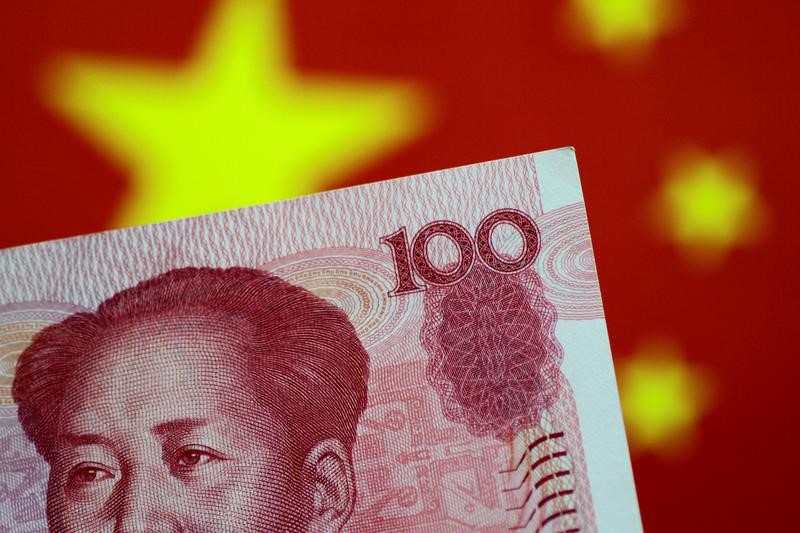(Bloomberg) -- For more than a month, China seemed to be enjoying the advantage of exchange-rate depreciation without the global backlash and panicky capital outflows that accompanied the bout of yuan weakening in 2015. Then Donald Trump took issue.
The U.S. president’s charges that China is “manipulating” a currency that’s been “dropping like a rock” came at the end of a six-week slide in the yuan that took it to its lowest level in more than a year against the dollar. The remarks, in a tweet and an interview with CNBC, suggested to market participants that the U.S.-China trade war is now broadening to include currencies, putting fresh scrutiny on Chinese management of the yuan.
After overseeing a slide in the yuan of almost 5 percent since mid-June, the question for Chinese officials now is whether to turn to other policy measures to support growth in the face of headwinds to exports. Wang Tao at UBS Group AG is among those predicting China will use other tools than the exchange rate to “cushion the blow” from the trade war.
“The central bank will work to stabilize the currency,” Wang, UBS’s head of China economic research in Hong Kong, said in a Bloomberg Television interview. “So what can China do? At this moment I think they can ease some of the tightening” in credit and fiscal policy, to support infrastructure investment, she said.
China set the reference rate for the onshore yuan at 6.7593 Monday, compared with a forecast 6.7554. The offshore yuan was little changed at 6.7764 as of 9:17 a.m. in Shanghai.
Trump’s criticism aside, China watchers have highlighted how the yuan’s depreciation this time around is better understood by investors as a reflection of economic fundamentals, rather than the 2015-style shock.
“A few years ago we didn’t have a story to justify the yuan weakening,” said Iris Pang, greater China economist at ING Bank in Hong Kong. “It was the PBOC that triggered the sudden yuan devaluation, without any notice or without any hints,” she said of the People’s Bank of China in 2015.
While the yuan has had effects on markets -- for example, futures contracts on the S&P 500 Index, Asian equities and oil all dropped for a time Friday after China cut the yuan’s daily reference rate the most in more than two years -- the impact has been limited.
The S&P 500, for example, remains on track for a fourth consecutive month of gains, compared with its 6.3 percent decline of August 2015. While Chinese stocks have entered a bear market, with the CSI 300 Index down about 20 percent from its January peak, that’s occurred alongside softening growth and worries over rising corporate defaults.
Market Driven?
As China’s officials determine whether to respond to Trump’s yuan manipulation charge, economists say there are clear arguments for a cheaper Chinese currency, justifying the current weakness.
“The currency should be depreciating from a broad macro perspective -- you have the Fed hiking and PBOC easing, so at some point it will be reflected in the FX market,” Frederic Neumann, co-head of Asian economics research at HSBC Holdings Plc (LON:HSBA) in Hong Kong, told Bloomberg Television. “This is still in line with the broader PBOC policy of introducing more volatility and letting the market play itself out.”
Bloomberg Economics estimates that the yuan is around 6.6 percent overvalued, based on economic fundamentals. Fielding Chen and Tom Orlik wrote in their analysis Friday that “there’s a sense that the decline is in line with Beijing’s wishes and -- if they want -- under their control.”
Even so, China has reasons to avoid sustained declines in the yuan. Earlier this decade it burned through about $1 trillion of reserves to stem an exodus of capital. And this June saw $10.7 billion in cross-border outflows, Morgan Stanley (NYSE:MS) estimates.
Chinese authorities have taken steps to ensure the slide doesn’t get unwieldy. After a 2 percent drop over the space of a week, PBOC Governor Yi Gang and other senior officials in early July underscored that China favored a stable currency. Again on Friday, after the morning tumble in the yuan began unsettling Asian investors, there were signs of action to stem the decline.
“Chasing USD/CNY higher is probably the wrong trade,” Goldman Sachs Group Inc (NYSE:GS). strategists including Zach Pandl in New York wrote in a note to clients Friday, referring to the dollar-yuan currency ticker. The yuan “will be more stable, as the U.S. could interpret further depreciation as a form of retaliation,” they said, sticking with a three-month forecast of 6.7 per dollar. “For now.”
(Updates with economist’s comment starting in third paragraph.)
